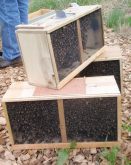Despite the prolonged cold weather Manitoba endured last winter, bee mortality actually declined in the province.
“We’re calling it a high normal,” said Rheal Lafreniere, Manitoba’s provincial apiarist.
“When we take all the numbers that got reported to us, mortality came out to around 24 per cent.”
Normal winterkill numbers fall between 15 and 25 per cent, he added, noting that in 2012-13 the average winter loss — including spring culls — was calculated at 46.4 per cent.
“Twenty-four per cent is still high, so we’re not calling it a great year, but we’re not calling it a bad year either,” Lafreniere said.
Losses are calculated using a mail-out survey. This year 63 beekeepers responded, representing just over 50 per cent of the province’s colonies.
Apiarists also provide the top three causes they attribute bee mortality to, although Lafreniere notes that responses are anecdotal, adding there may be other causes of mortality not yet considered.
Seventeen per cent of bee deaths were blamed on cold winter weather, according to the survey, while a further 18 per cent were attributed to an unseasonably cold spring.
Starvation was thought to be the cause of colony loss 28 per cent of the time, while only two per cent of the overall losses were believed to be caused by the varroa mite.

Lafreniere said that losses where highest in northwestern Manitoba, where cold weather lingered longest. Winter losses averaged 35 per cent in that area, while the area around Winnipeg had losses in the 10 per cent range.
“But we’ve still got individuals in that northwest area who reported 50 per cent losses… so there are still some hard-hit beekeepers in Manitoba — we haven’t solved all the reasons for the losses,” said the apiarist.
Manitoba’s losses reflect the national average of 25 per cent, but Lafreniere points out that Ontario’s wintering loss sits at a whopping 58 per cent, skewing the Canadian average. Leave Ontario out of the equation and national mortality rate drops to 19.2 per cent.
According to a report issued by the Canadian Association of Professional Apiculturists, “in Ontario and Quebec, some beekeepers cited acute and chronic pesticide damage or lack of sufficient recovery from a pesticide incident the previous year as a contributing factor in winter mortality.”
Read Also

Still hard to predict precise fertilizer payback
Despite decades of advances, international research finds no clear answer for where and when adding nutrient will fail to boost growth.
A class-action lawsuit launched by two large Ontario honey producers against Bayer Inc. and Syngenta International AG earlier this month claims the companies were negligent in making, selling and distributing pesticides, causing beekeepers in that province to suffer damages and losses.
According to Manitoba’s winter loss survey, only five per cent of beekeepers in this province attribute the loss of their bees to pesticide use.
Last week, the federal government announced $250,000 in funding for the Centre de recherche en sciences animales de Deschambault in Quebec, with the stated goal of improving bee health and optimizing profitability of honeybee colonies. No mention of pesticides was made.
“In partnership with the Agriculture and Agri-Food Canada’s Beaverlodge Research Farm, this project will focus on the development of sustainable alternative strategies to control some particularly insidious diseases that are responsible for major losses of bee colonies,” said Jean-Paul Laforest, president of the research centre.
Despite winter losses, Lafreniere said Manitoba beekeepers are doing well to replenish numbers this summer.
Although the final numbers won’t be in for some time, this year’s honey harvest is also looking promising.
“I’m generally hearing average production, and maybe even slightly above-average production,” he said.















